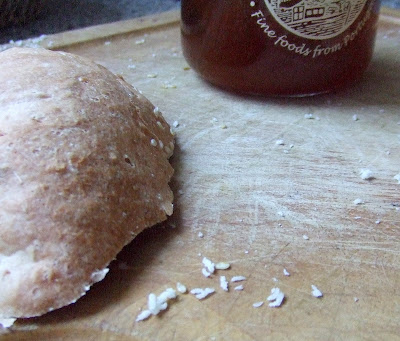
The impending arrival of Rosh Hashanah (the Jewish New Year) brought on an unexpected desire to bake challah.
While I enjoy the process of preparing dough and bake pizza and/or chapatti about once a week, I am lucky to have a phenomenal bread selection—3 bakeries, ranging from quite good to excellent and covering between them sourdough, baguettes, granary and Central European seeded loafs—just down the street. It seems foolish, therefore, to expend time producing an inferior loaf. But as challah isn’t on the rota of any of these shops, nor is there anything like a critical mass of celebrating Jews in Brixton to generate sufficient demand for a holiday special, I felt like I could indulge my whim without any unfavourable comparisons to professional products.
My mother’s challah recipe is justifiably requested by many who eat at her table. But it wasn’t quite what I had in mind: too large to be easily consumed during its short shelf-life (unlike my father, I’m not a big fan of French toast) and not the most obvious match to the Sephardic meal I had planned. Instead I unloaded the books of Claudia Roden (whose Book of Jewish Food demonstrates little interest in Ashkenazic cuisine but is an unparalleled resource on the food eaten by Sephardim from Libya to India to Turkey) and Joan Nathan (whose books on Israeli food and French-Jewish food capture how North African Jewish food in particular has been transplanted and adapted to different milieu over the last 60 years) and got to work.
Based on the evidence provided, the challah of Tunisian Jews differs from the Ashkenazic standard only in its particular braiding and shape. By contrast, Algerian and Moroccan Jews use quite distinctive flavourings of anise and sesame seeds. The more refined versions of these challot, known as pain petri, are enriched with vegetable oil, egg and more sugar; some were also braided and glazed with egg yolk. The simpler are just lightly sweet, flavoured loaves, slightly flatter and wider than a conventional challah. (I also found one version, intended for the dairy break-fast meal after Yom Kippur, the Day of Atonement, where the water was substituted with milk. This is very similar to other Moroccan bread recipes not specifically associated with its Jewish population.)
I settled on the simplest version, known as a pan de casa in the dialect spoken by some Moroccan Jews. The dough came together easily and was ready to be shaped into a free-form loaf after about 90 minutes of rising time. After a further half hour, it was sprinkled with more sesame seeds and went into a medium-hot (375C or 190F) oven for 30 minutes.
It may not have been quite the challah of my youth, but my guests, who included an Anglican vicar and an Austrian Catholic, seemed unperturbed by any perceived break from tradition and very pleased with the taste.
Pan de Casa
adapted from Joan Nathan’s The Food of Israel Today
Total time: 2 ¾ hours; Active time: 15 minutes
I used a scant 2/3rds of the measurements given to make one free-from loaf large enough to feed four as a starter with dips, with leftovers for breakfast the next morning. I give the original measurements below, with the suggestion that the three smaller loafs are instead shaped into two slightly larger, higher ones. I did not find that this affected the baking time, but it may well require a few more minutes in other ovens.
The only other adjustment made was in substituting bread flour for all-purpose. I was advised by my mother than this would enable more gluten development and a higher, lighter loaf. (It seems to have worked.)
This dough makes a relatively soft crust. If you’d like something crisper, you might try putting the dough into a hotter oven, then immediately turning it down, or allowing it to cool in the switched-off oven, keeping the door open.
5 cups bread flour
1 tablespoon instant yeast
2 tablespoons sugar
1 tablespoon salt (I tend to use a bit more than called for in most bread recipes)
1 tablespoon anise seeds
1 tablespoon sesame seeds, with more to sprinkle on the shaped, unbaked loaf
1 ¾ cups warm water
Add the flour, yeast, sugar, salt and seeds to a large bowl. Pour in the water gradually, mixing by hand or with a large spoon to make a rough, slightly wet dough. (Add a bit of flour or water if the dough isn’t coming together.)
Turn out the dough onto a well-floured surface and knead until smooth and pliable, up to 10 minutes. Place back in the bowl, cover well and let rise in a slightly warm place until doubled, about 90 minutes.
Preheat the oven to 375C (190F). Grease two cookie or baking sheets. Punch back the dough and divide into two balls. Shape as desired and place on the cookie sheets. Sprinkle with additional sesame seeds. Cover and allow to rise for a further 30 minutes.
Bake the loaves for 30 minutes, or until they sound hollow on the bottom. Allow to cool fully before slicing.
1 comment:
Hi! My name is Ryan and I’m the editor of howtocookfantasticfood.com. I think you have an awesome food site so I posted a link to it in our blog directory. I wasn't able to find your email address on your site but I’d like to invite you to be a part of our Featured Website program. I would love to send you more details about the program, so if you are interested, please email me at ryan [at] howtocookfantasticfood [dot] com.
Post a Comment